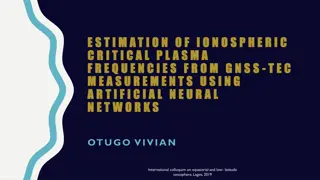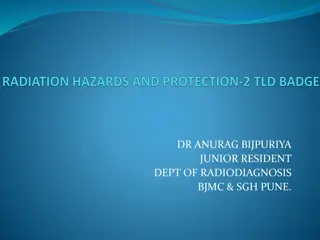Four-Year Plan for WMO Space Weather Activities 2024-2027
Space Weather is a crucial aspect of the natural space environment affecting various technologies on Earth and in space. The plan outlines goals, historical context, and key recommendations by INFCOM-3 for monitoring and modeling solar, magnetospheric, and ionospheric activities. Integration of Spac
0 views • 9 slides
Advanced Fission Experiments at University of Michigan
The University of Michigan, under the guidance of Dr. Sara A. Pozzi, conducts cutting-edge fission experiments leveraging organic scintillation detectors. These detectors offer advantages such as nanosecond-scale response times, energy proportionality, and scalability. The experiments focus on impro
0 views • 4 slides
Optimum Solar Proxy for Long-Term Ionospheric Studies
The search for the best solar proxy for long-term ionospheric studies is ongoing due to the lack of consistent solar radiation data. Various solar proxies have been analyzed, and the use of Mg II for foF2 and F10.7 for foE has shown promising results, describing a high percentage of variance in the
1 views • 10 slides
Estimation of Ionospheric Critical Plasma Frequencies Using GNSS Measurements
This research focuses on estimating the critical plasma frequency of the ionosphere, specifically the F2 layer (f0F2), using GNSS measurements. The study reviews past work on ionospheric modeling, discusses neural network training inputs, and presents a single station neural network model (NNT2F2).
0 views • 26 slides
Cutting-edge Technology at Sodankyl Geophysical Observatory
The Sodankyl Geophysical Observatory in Finland utilizes state-of-the-art technology for ionospheric research, including the Alpha-Wolf sounder, a sophisticated transmitter, and receiver array. The observatory has a rich history of ionosonde operations since 1957, with continuous advancements in dat
2 views • 23 slides
Advancements in Doping Liquid Argon with Xenon: Historical Overview
Delve into the historical review and latest developments of doping liquid argon with xenon, aiming to shift light wavelengths for improved visibility in TPC volumes. Key questions address the effect on scintillation components, stability of xenon doping, and potential ice cluster formation. Early st
0 views • 27 slides
Understanding Electroluminescence Time Projection Chamber (EL TPC) Physics
Delve into the fundamentals of Electroluminescence Time Projection Chambers (EL TPCs) through concepts like electron drift, scintillation mechanisms in noble gases, and charge yield estimation. Explore the workings of EL TPC prototypes, such as ZEPLIN II/III and DarkSide, for applications like react
0 views • 23 slides
Radiation Detection and Dosimetry in Medical Imaging
Radiation detection and measurement are essential in radiology. Various instruments like ionization chambers, film badges, thermoluminescent dosimeters, and pocket dosimeters are used to monitor radiation exposure. Personnel dosimetry is crucial for tracking radiation doses over time to ensure safet
2 views • 31 slides
Nanoparticle-Enhanced Readout for Crystal Calorimetry: BaF2 Scintillation Detection
Nanoparticles with specific absorption and emission properties are explored to enhance the readout process for BaF2 crystal calorimetry, focusing on detecting the fast 220nm UV component. The goal is to achieve a large Stokes shift to the visible wavelength range for efficient detection, while minim
0 views • 7 slides
Advanced Calorimeter Technology for Particle Detection
Cutting-edge calorimeter technology for high-energy physics experiments is discussed in this content. The focus is on radiation-hard crystal scintillators and plastic scintillator-based Shashlik technology used in the present ECAL. Details about the requirements, materials, irradiation tests, and ad
0 views • 16 slides
GNSS Ionospheric Study in Korea: Insights and Findings
Explore the status of GNSS ionospheric study in Korea, including details on Korea's GPS permanent network, IGS, KASI Global Data Center, TEC mapping, and ionospheric tomography. Discover how ground-based GPS data is used to study ionospheric electron densities and monitor ionospheric storms in Korea
0 views • 15 slides
Update on Ionospheric Studies Task Force (ISTF/4) Meeting in Philippines
The ISTF/4 meeting in Philippines provided updates on data collection tasks, including current and planned data sources. The report highlighted the total number of operating stations, types of data collected, and progress on new site installations. Additionally, updates on the use of data within CAA
0 views • 4 slides
Understanding Ionospheric Absorption Laws and Regions
The principles of the ionosphere at middle and low latitudes, Lambert-Beer exponential absorption law, and characteristics of E and F regions are discussed. The absorption of solar radiation, recombination reactions in different regions, and ionization processes are highlighted, providing insights i
0 views • 15 slides
Recent Insights into Mars Ionosphere Studies with MARSIS-AIS
Discover recent research on the Martian ionosphere conducted by scientists using various instruments such as MARSIS, MAVEN, and MarMCET. Explore studies on electron density profiles, ionospheric traces, and the timing issue correction of the AIS sounding cycle. Publications address improvements in a
0 views • 6 slides
Advancing the Living with a Star Program: Science Goals and Community Priorities
The Living with a Star (LWS) program, led by a dedicated steering committee, aims to provide yearly reports, set long-term visions, and address key science topics in solar and space physics. The community priorities include enabling discovery and addressing societal needs, emphasizing the importance
0 views • 11 slides
Implementation of Cornell Ionospheric Scintillation Model in Spirent GNSS Simulator
Researchers from the University of Nottingham and Spirent Communications collaborated to implement the Cornell Ionospheric Scintillation Model into the Spirent GNSS Simulator. The study focuses on the diffractive effects of ionospheric scintillation on GNSS signals, examining small-scale plasma irre
0 views • 24 slides
Investigation of Low-Latitude S-Band Ionospheric Scintillations during September 2017 Geo-Magnetic Storm
The study focuses on analyzing the impact of geo-magnetic storms on NAVIC satellites, particularly the S-band signal, during September 2017. Researchers from K.L. Deemed to be University observed variations in solar and geomagnetic activity indices, providing insights into the behavior of the ionosp
0 views • 15 slides
Study on Ionospheric Perturbation Due to Solar and Geomagnetic Activity in Odessa Magnetic Anomaly
Research conducted in the area of the Odessa magnetic anomaly investigates ionospheric perturbations caused by solar and geomagnetic activity. The study utilizes radio astronomical and magnetometric observations from various observatories, highlighting the significance of the geomagnetic anomaly nea
0 views • 18 slides
Status of GATE-related Projects at Helmholtz-Gemeinschaft
Helmholtz-Gemeinschaft's GATE-related projects involve research on PET-detector designs for BrainPET-insert, simulations of scintillation processes, and challenges with computing time for optical photon studies. Suggestions for improving efficiency are being discussed in the Steering Committee.
0 views • 11 slides
Advancements in Liquid Argon Time Projection Chamber Technology
Explore the capabilities of the DUNE project with a focus on the Far Detector conceptual design, operating principles of Single Phase LAr TPC, and advantages/disadvantages of liquid argon as a detection medium. The innovative technology allows for precise tracking at the sub-1mm level and facilitate
0 views • 36 slides
Comparison of MSTID and Sporadic E Distributions in Ionosphere Study
Investigating the role of sporadic E in medium-scale traveling ionospheric disturbances by comparing its distribution with MSTID using CHAMP satellite data. Sporadic E and MSTID occurrences, detection methods, and distribution patterns in different hemispheres are explored, revealing seasonal variat
0 views • 9 slides
Performance of Scintillation Pixel Detectors with MPPC Read-Out and Digital Signal Processing
Mihael Makek presents the performance evaluation of scintillation pixel detectors with MPPC read-out and digital signal processing at the 2nd Jagiellonian Symposium on Fundamental and Applied Subatomic Physics in Krakow, 2017. The study includes the construction and testing of segmented detector arr
0 views • 25 slides




















